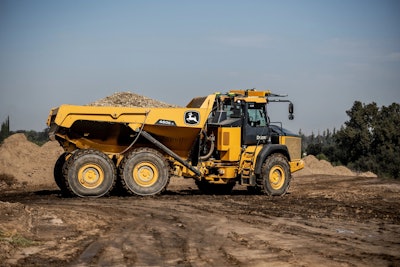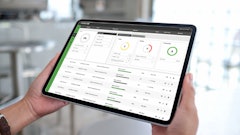
Maya Sripadam didn’t grow up around equipment yards or construction job sites. She grew up in Silicon Valley, surrounded by emerging technology, and pursued her interest in robotics through machine learning at Carnegie Mellon University. Today, she’s at the forefront of one of John Deere’s boldest initiatives — bringing autonomy to the construction and farming industries. As part of that mission, she works for Deere’s technology innovation division, Blue River Technology, where the company is building smart, self-directed machines to solve some of the industry’s most pressing workforce and productivity challenges. And while her current work centers on autonomous articulated dump trucks, it’s worth noting that John Deere also owns the Wirtgen Group family of machines — including HAMM asphalt rollers, Wirtgen milling machines, Vögele asphalt pavers and Kleemann crushers. The advancements in robotics and automation Sripadam is helping to shape could one day find their way into the very machines that contractors operate every day.
Sripadam serves as a senior product manager for John Deere through its technology innovation division, Blue River Technology. The company first made its name in agriculture, developing robotic solutions like See & Spray, which uses computer vision to distinguish crops from weeds and target only the weeds with herbicide. But the team's focus didn’t stop there.

From Farm Fields to Job Sites
After contributing to Deere’s fully autonomous tractor — a headline-grabbing breakthrough in agriculture — Sripadam and her team turned their attention to construction, where the same labor and productivity pressures were just as real, if not more so.
“We realized that the labor shortage is not something that is just unique to the agriculture industry,” Sripadam said. “It might even be more prevalent in construction.”
Her current focus is John Deere’s autonomous articulated dump truck (ADT), the first of its kind for the company’s construction lineup. The ADT is designed for quarry and earthmoving operations, where jobs are often repetitive, physically demanding and run on a tight schedule. Any delay in one truck’s cycle can disrupt the productivity of an entire operation. With autonomy, Sripadam explained, that bottleneck risk is eliminated.
“We’re building a foundational autonomy stack,” she said. “That started in agriculture, and now it’s being applied in construction. That’s the program I work on.”
The ADT was one of four of Deere’s new autonomous machines unveiled at CES 2025 in Las Vegas, marking a strategic shift for the company into high-tech equipment for quarry, commercial landscaping and infrastructure sectors. The timing could not be more urgent. With a global population expected to reach nearly 10 billion by 2050, demand for both food and infrastructure is growing. “If it’s not grown, it likely comes from a quarry,” Sripadam said during the CES presentation. For her, autonomy is not about futuristic ambitions. It’s about solving real-world problems for industries that are already stretched thin.
Learning from the Ground Up
Sripadam’s role is not only about technology development, but also understanding the daily realities of those who operate this equipment.

“Deere equipment covers the equivalent of one-third of the surface of the Earth,” she said. “So much of the food, fiber and fuel that we rely on comes from hardworking people using this big equipment. Our part in that picture is helping give those people back time — time that’s becoming a very scarce commodity.”
Sripadam's path into robotics and automation was shaped by a desire to see machine learning applied in physical, tangible ways. “Software products are awesome, and we rely on them every day,” she said, “but I really wanted to physically see my work manifest.”
That mindset ultimately brought her to robotics, and to Deere. But when she first entered the field, she knew her technical skills alone wouldn’t be enough. She lacked the domain knowledge that many in construction take for granted — things like jobsite logistics, operator habits or loading cycles. To close that gap, she did what many technologists overlook: she listened.
“You just have to put in the hours,” she said. “Ride shotgun in a tractor. Be on a job site. Be in a quarry. Ask people to describe their day. Ask what they’re thinking about when they make a decision.”
Data That Drives Decisions
Sripadam emphasized that this learning process shouldn’t begin with a product pitch or a prototype in hand. “Don’t go in with the agenda of trying to solve a problem. Just understand the fundamentals,” she said.
That hands-on approach helped her understand how autonomy might fit into real workflows, and it also clarified how success should be measured. One of Sripadam’s passion topics is analytics and performance metrics. She believes that even the most advanced autonomous system can fall short if it lacks visibility.
“Without robust analytics, you're almost running blind,” she said. “You’ll put the product in the field and someone will say, ‘It’s not working,’ but unless you know why it's stopping, what it’s stopping for and how many times it’s stopping, you’ll never solve the problem quickly.”
She advocates for building analytics capabilities from the start, not as an afterthought. Understanding what data matters most requires close collaboration with customers, something she and her team prioritize. “It really comes from sitting with customers and understanding how they're going to measure success,” she said.
Sripadam’s interest in simplification has also shaped her perspective on product development. In robotics, it’s easy to assume that a product needs to do more to be compelling. She’s learned the opposite.
“When you’re solving a fundamental problem that hits a huge macroeconomic trend like labor availability, your product can actually be really simple and yet really delightful,” she said.
Clearing a Path Into Robotics
When asked what she believes holds people back from pursuing careers in STEM or robotics, Sripadam pointed inward rather than outward. “We can be our own biggest self-limiters,” she said. “If you look at the space from a bird’s eye view, there is a ton of opportunity and work that needs to get done.”
What matters, she explained, is having confidence to deal with ambiguity, the commitment to gain the technical skills required and the willingness to invest time. “It doesn’t matter what your background is — you can pivot and move into this field.”
Sripadam encourages others to start small, even if it’s just experimenting with AI tools like ChatGPT to help write an email. “Start using what's available,” she said. “Start learning how to incorporate it, even on a small scale. Understand why it was created and how it was built.”
This accessibility, she believes, is the key to making robotics feel less like an exclusive club and more like a career path anyone can pursue. With robots and AI becoming a part of everyday life, she sees early exposure as essential.
“Robots are going to become commonplace,” she said. “We’re going to find them in pretty much every aspect of life. Learning how to use them now will help us all be more effective at our jobs in the future.”
What’s Next?
Looking ahead, Deere’s autonomy strategy is focused on building shared intelligence across applications. By collecting data across agriculture, construction, and landscaping platforms, each machine in the field can get smarter, more efficient and more useful over time.
“Every single individual application is going to get better from it,” Sripadam said. “That’s core to our strategy and core to building the best possible products for our customers.”
Her perspective is grounded in empathy, data, and a clear understanding of what’s at stake. Autonomy, for her, is not about replacing people. It’s about giving them tools that restore balance in a world demanding more than ever.
“Our customers should have access to the best technology that will help them be more efficient, more productive, and get time back,” she said.
For Maya Sripadam, that’s what innovation looks like: not science fiction, but solutions — built to work, built to learn, and built to serve the people at the heart of it all.


















